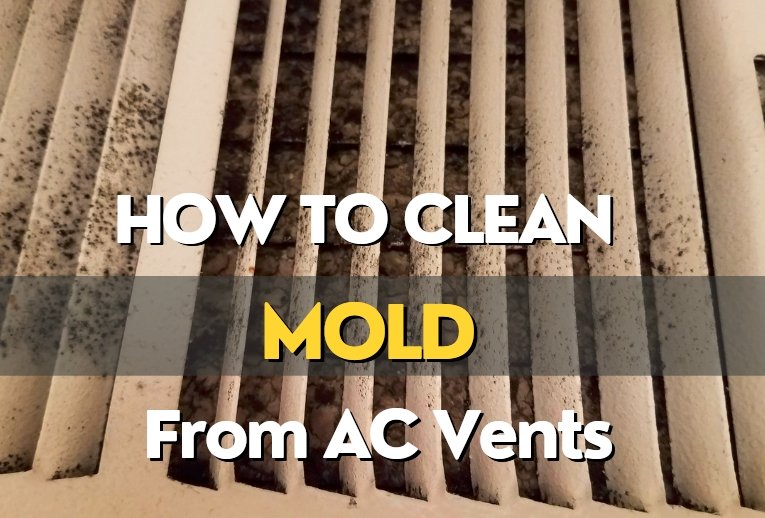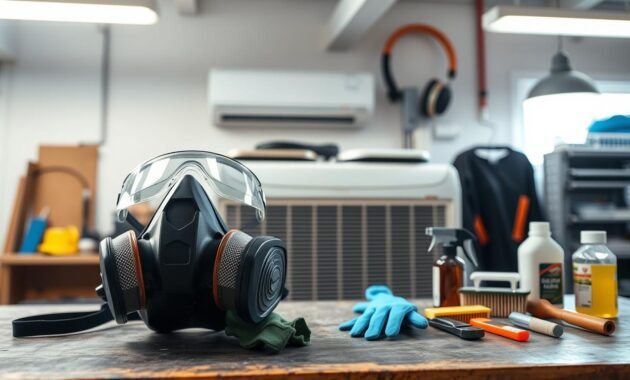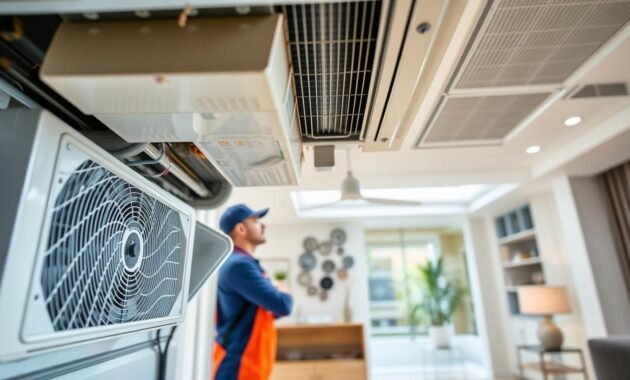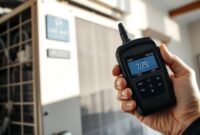Finding mold in your air conditioner vents is a big problem for homeowners. It smells bad, can be harmful to your health, and looks ugly. Mold in air ducts can spread fast, making your indoor air dirty and risky for your family.
I’ll show you how to fix mold in your AC system. My detailed plan will help you get rid of mold from your air conditioner vents. You’ll learn how to improve your indoor air quality and stop mold from coming back. We’ll cover everything from finding the mold to using professional cleaning methods.

Understanding the Dangers of Mold in AC Systems
Mold in your HVAC system can be very dangerous. It can spread mold spores through your air conditioning. This can harm you and your family. Let’s talk about the risks and why you need to fix mold growth.
Common Health Risks from Mold Exposure
Mold can hurt your health in many ways. It mainly affects your breathing and overall health. Here are some common symptoms:
- Persistent coughing and wheezing
- Nasal congestion
- Skin rashes
- Eye irritation
- Throat discomfort
Signs of Mold Infestation in Your AC
Spotting mold early can stop bigger health problems. Look out for these signs:
- Musty or unpleasant odors when the AC runs
- Visible black or green growth around vents
- Unexplained allergic reactions
- Increased humidity near air conditioning units
Impact on Indoor Air Quality
Your HVAC system can harbor mold spores. This can spread contamination everywhere in your home. Black mold is very dangerous and can cause serious breathing problems and long-term health issues. It’s important to regularly check and clean your air conditioning system.
Getting professional HVAC maintenance can find and remove mold early. Don’t ignore the signs – your family’s health depends on clean air.
Identifying Mold Growth in Air Conditioner Vents
Finding black mold in ac vents needs careful watching and knowing the signs. I’ll guide you on how to spot mold early. Spotting it early keeps your air clean and stops damage to your AC.
Read also: Can Air Conditioning Give You A Cold?
When checking your air conditioner vents, look for these signs of mold:
- Musty or unusual smells from the vents
- Dark or discolored spots around vent openings
- Unexplained breathing problems in your family
- Too much moisture or condensation near AC units
Cleaning your air conditioner vents is key when you see these signs. Start by looking closely at vent covers and nearby areas for any odd growths or color changes. Dark green, black, or brown spots usually mean mold.
Some signs that show serious mold problems include:
- Constant allergic reactions when the AC is on
- Visible spore clusters around vent edges
- Unexplained water stains near ventilation systems
- Less airflow from certain vents
If you’re not sure about mold, take photos and talk to an HVAC expert. They can do a full check and help with cleaning and stopping mold in your AC system.
Essential Tools and Materials for Mold Cleaning
Getting ready to remove mold needs careful planning and the right tools. Cleaning mildew from AC ducts requires specific equipment and safety steps. I’ll show you the key items for tackling mold in your air conditioning system.
Safety Equipment Required
Protecting yourself is the first step in any mold removal project. You’ll need the following safety gear:
- N95 respirator mask
- Chemical-resistant gloves
- Safety goggles
- Disposable protective clothing
Cleaning Solutions and Supplies
Choosing the right cleaning solutions is key for removing mildew from AC ducts. You’ll need:
- White vinegar
- Hydrogen peroxide
- Commercial mold removal spray
- Microfiber cloths
- Spray bottles
Specialized Tools Needed
Professional mold removal needs specific tools for tight spaces in AC vents. You should get:
- Extendable scrub brush
- HEPA vacuum cleaner
- Flexible cleaning attachments
- Disposable cleaning wipes
- Protective drop cloths
Having these tools ready will make your mold removal safer and more efficient. Always put your health first and take the right precautions when dealing with mold in your air conditioning system.
Safety Precautions Before Starting the Cleaning Process

When you start cleaning air vents, safety comes first. Mold can be harmful, so it’s key to protect yourself. Here are the important steps to keep you safe and clean effectively.
Before you begin removing mold, you need to take some important steps:
- Turn off the entire HVAC system completely
- Disconnect power to the air conditioning unit
- Wear appropriate protective gear
- Ensure proper ventilation in the work area
Protective gear is a must for mold removal. Make sure you have:
- N95 respirator mask
- Protective goggles
- Disposable gloves
- Long-sleeved clothing
Good ventilation is key for cleaning. Open windows and doors to improve air flow. If you can, use fans to blow air outside. Some mold jobs are too big for DIY. If you see a lot of mold or feel unsure, call a pro HVAC service.
Your health is the most important thing when dealing with mold in air conditioning. By following these steps, you’ll stay safe and clean well.
How to Clean Mold from Air Conditioner Vents
Cleaning mold from air conditioner vents is vital for AC maintenance. It keeps your home’s air clean and prevents health risks. I’ll show you how to remove mold and keep your AC system working well.
Step-by-Step Cleaning Process
Before you start, make sure you’re prepared. Here’s what you’ll need:
- Protective gloves
- Safety goggles
- Respirator mask
- Screwdriver
- Soft-bristled brush
- Cleaning solution
- Microfiber cloths
Cleaning Solution Options
There are many cleaning solutions for AC maintenance:
- White vinegar (natural and non-toxic)
- Hydrogen peroxide solution
- Commercial mold removal products
- Mild bleach solution (diluted)
Proper Application Techniques
Follow these steps for cleaning mold from air conditioner vents:
- Turn off your HVAC system completely
- Remove vent covers carefully
- Vacuum visible mold using a HEPA filter vacuum
- Apply chosen cleaning solution with a soft brush
- Wipe thoroughly with clean microfiber cloth
- Allow vents to dry completely before reinstalling
Regular cleaning and maintenance stop mold growth. This keeps your AC system efficient and healthy.
Natural Cleaning Methods Using Vinegar and Baking Soda
Natural cleaning solutions are great for preventing mold in HVAC systems. Vinegar and baking soda are safe and effective alternatives to harsh chemicals.
White vinegar is a top choice for fighting mold. Its acidity stops mold from growing. Use undiluted white vinegar for the best results. Spray it on moldy areas, wait an hour, then wipe clean.
- Use 5% white vinegar concentration
- Apply directly to moldy surfaces
- Allow 60 minutes of contact time
- Wipe with clean microfiber cloth
Baking soda helps vinegar by soaking up moisture and removing smells. Mix it with water to make a paste. This paste is good for scrubbing mold off porous surfaces.
| Cleaning Agent | Effectiveness | Application Method |
|---|---|---|
| White Vinegar | High | Direct spray, 60-minute contact |
| Baking Soda | Medium | Paste scrubbing technique |
While these methods are good for small mold problems, big infestations need a pro. Regular upkeep and quick action against moisture help keep mold away from your HVAC system.
Chemical Solutions for Stubborn Mold Removal
When natural cleaning methods don’t work, chemical solutions are key for mold removal in your HVAC system. Stubborn mold needs strong methods to remove it fully and avoid health risks.
Not every mold problem can be fixed with simple home remedies. Some need strong chemicals to tackle deep mold in air conditioning vents.
Bleach-Based Solutions
Bleach is a strong tool against mold in your HVAC system. Here are important things to remember when using bleach for mold removal:
- Dilute bleach with water at a 1:10 ratio
- Wear protective gear like gloves and masks
- Ensure proper ventilation during application
- Test on a small area first to prevent surface damage
Commercial Mold Removers
Professional mold removal products offer special solutions for tough mold problems in HVAC systems. These cleaners often have:
- Advanced antimicrobial agents
- Targeted mold and mildew eliminators
- EPA-registered formulations
- Long-lasting protective treatments
Always follow the manufacturer’s instructions carefully. Safety is key when using chemical mold removal solutions in your air conditioning system.
Preventing Future Mold Growth in AC Vents

To keep your AC vents mold-free, you need to take action early. As a homeowner, I’ve found that stopping mold before it starts is much easier. Your HVAC system must be well-maintained to keep your home healthy.
Stopping mold growth starts with knowing what causes it. Moisture is the main enemy, so keeping humidity levels in check is key to protecting your AC.
- Maintain indoor humidity between 30-50%
- Replace air filters every 90 days
- Schedule professional HVAC inspections annually
- Use dehumidifiers in high-moisture areas
- Ensure proper ventilation throughout your home
Here are some smart ways to stop mold in your AC system:
| Prevention Method | Frequency | Effectiveness |
|---|---|---|
| Regular Air Filter Replacement | Every 3 months | High |
| UV Light Air Purification | Continuous | Very High |
| Professional HVAC Cleaning | Annually | High |
Using advanced tech like UV light air purifiers can really help. These devices kill mold and bacteria constantly. They add a strong layer of protection to your home’s air.
By sticking to these maintenance tips, you’ll make your home less welcoming to mold. Remember, it’s cheaper to prevent mold than to fix it after it happens.
When to Call a Professional HVAC Service
Dealing with mold in your hvac system can be tough. DIY solutions might not work for big mold problems. Knowing when to call a pro can keep your home safe and healthy.
It’s important to call experts in certain situations. This can prevent health issues and damage to your property.
Signs of Severe Mold Infestation
- Extensive mold coverage spanning more than 10 square feet
- Recurring mold growth after multiple cleaning attempts
- Visible structural damage around vents and ductwork
- Persistent musty odors throughout your living space
- Unexplained respiratory issues or allergic reactions
Professional Cleaning Services Available
Professional mold remediation services can handle tough hvac system mold issues. They use special tools and methods to get rid of mold for good.
Read also: When to Use Fan Mode in AC?
| Service Type | Typical Procedures | Estimated Cost Range |
|---|---|---|
| Basic Mold Inspection | Visual assessment, air quality testing | $200 – $500 |
| Complete HVAC Mold Remediation | Comprehensive cleaning, sanitization, ductwork treatment | $500 – $2,500 |
| Advanced Remediation | Structural repairs, complete system replacement | $2,500 – $6,000 |
When picking a professional service, check their credentials and experience. Make sure they’re certified in mold remediation. Ask for a detailed quote and understand their approach to fixing your hvac system.
Maintaining Clean AC Vents Year-Round
Keeping your air ducts clean is key for better indoor air. I’ll share tips for year-round AC vent care. These will help stop mold and keep your system running well.
Regular upkeep is vital for your AC’s health. Make a detailed maintenance plan for your AC system.
- Do monthly checks on air ducts
- Change air filters every 60-90 days
- Use fan mode to cut down moisture
- Deep clean at each season’s end
I’ve made a checklist to track your maintenance:
| Maintenance Task | Frequency | Purpose |
|---|---|---|
| Air Filter Replacement | Every 2-3 months | Improve air quality and system efficiency |
| Vent Cleaning | Quarterly | Remove dust and prevent mold growth |
| Professional Inspection | Annually | Comprehensive system check |
Follow these tips to boost your indoor air and AC system’s life. Remember, it’s cheaper to prevent problems than fix them!
Conclusion
Keeping your air conditioner vents mold-free is key for better indoor air. This guide has shown you how to clean and protect your home’s air. It’s all about keeping your air clean and healthy.
Preventing mold is easier than treating it. Use the cleaning and prevention tips from this guide. Regular checks, controlling humidity, and cleaning on time are vital for good air quality.
While DIY cleaning works well, some mold needs a pro. If you see a lot of mold or are unsure, call an HVAC expert. Your health and AC system’s performance depend on it.
It’s time to act. Check your AC vents, get your cleaning tools ready, and stick to a maintenance plan. Clean air is essential for a healthy home.


